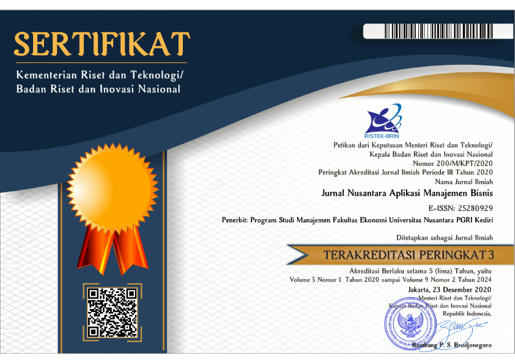FOCI Commitment pada Job Performance dengan Generasi X dan Y sebagai variabel Moderator
DOI:
https://doi.org/10.29407/nusamba.v8i1.18631Keywords:
Kinerja pekerjaan; FOCI komitmen; generasi X, generasi YAbstract
Research aim : The purpose of this study was to analyze the influence of generational differences in the interrelationships among affective commitment (AC) and sustainable job performance between Gen X and Gen Y employees.
Design/Methode/Approach: The research design used is correlational research that aims to test and analyze the influence of independent variables on dependent variables. The data used is primary data through questionnaires distributed through google form. The population of this study is all employees of Auto 2000 in Jakarta, Tangerang, Depok and Bekasi as many as 500 employees. The number of respondents used was 320 respondents where the sampling method used purposive sampling. The analysis tool used is the Structural Equation Model (SEM) using Smart-PLS software.
Research Finding : The results showed that one of three FOCI (affective commitment to the organization, affective commitment to the supervisor, and affective commitment to coworkers) was found to be positively related to job performance, namely contextual performance.
Theoretical contribution/Originality : From the results of data analysis, it is also concluded that the generation difference between generation X and generation Y does not affect FOCI on job performance.
Practitionel/Policy implication : The results of the study provide input for decision makers in companies that affective FOCI of commitment has a relationship with Job Performance. Therefore, company leaders can make good policies to improve employee performance.
Research limitation : This research has several limitations in the selection of dimensions of the FOCI of Commitment ( AC) affective variable, namely in the aspects of commitment to organization, commitment to supervisors, and commitment to coworker.
Downloads
References
[2] M. A. Hitt, R. D. Ireland, M. Camp, and D. L. Sexton, “Strategic Entrepreneurship: Entrepreneurial Strategies for Wealth Creation,” Strateg. Manag. J., vol. 2, no. 6–7, pp. 479–491, 2001.
[3] D. O. Almutairi, “The Mediating Effects of Organizational Commitment on the Relationship between Transformational Leadership Style and Job Performance,” Int. J. Bus. Manag., vol. 11, no. 1, p. 231, 2015, doi: 10.5539/ijbm.v11n1p231.
[4] A. Freund and A. Carmeli, “An empirical assessment: Reconstructed model for five universal forms of work commitment,” J. Manag. Psychol., vol. 18, no. 7–8, pp. 708–725, 2003, doi: 10.1108/02683940310502403.
[5] A. K. yee Leung, W. W. Maddux, A. D. Galinsky, and C. yue Chiu, “Multicultural Experience Enhances Creativity: The When and How,” Am. Psychol., vol. 63, no. 3, pp. 169–181, 2008, doi: 10.1037/0003-066X.63.3.169.
[6] H. T. Kuo, K. C. Lin, and I. chuan Li, “The mediating effects of job satisfaction on turnover intention for long-term care nurses in Taiwan,” J. Nurs. Manag., vol. 22, no. 2, pp. 225–233, 2014, doi: 10.1111/jonm.12044.
[7] S. E. Sullivan and M. B. Arthur, “The evolution of the boundaryless career concept: Examining physical and psychological mobility,” J. Vocat. Behav., vol. 69, no. 1, pp. 19–29, 2006, doi: 10.1016/j.jvb.2005.09.001.
[8] A. Al Adresi and M. R. Darun, “Determining relationship between strategic human resource management practices and organizational commitment,” Int. J. Eng. Bus. Manag., vol. 9, pp. 1–9, 2017, doi: 10.1177/1847979017731669.
[9] C. Burmann, S. Zeplin, and N. Riley, “Key determinants of internal brand management success: An exploratory empirical analysis,” J. Brand Manag., vol. 16, no. 4, pp. 264–284, 2009, doi: 10.1057/bm.2008.6.
[10] T. E. Becker, “Foci and Bases of Commitment: Are They Distinctions Worth Making?,” Acad. Manag. J., vol. 35, no. 1, pp. 232–244, 1992, doi: 10.5465/256481.
[11] A. Reichers, “‘A review and re-conceptualization of organizational commitment’, {Academy} of {Robbins},” Acad. Manag. Rev., vol. 10, no. 3, pp. 465–476, 1985.
[12] A. E. Reichers, “Conflict and Organizational Commitments,” J. Appl. Psychol., vol. 71, no. 3, pp. 508–514, 1986, doi: 10.1037/0021-9010.71.3.508.
[13] J. P. Meyer and N. J. Allen, “A THREE-COMPONENT CONCEPTUALIZATION OF ORGANIZATIONAL COMMITMENT,” Hum. Resour. Manag. Rev., vol. 1, no. 1, pp. 61–89, 1991, doi: 10.1057/9780230501997_5.
[14] Rodrigo Cunha da Silva; Joel Souza Dutra;Elza Fátima Rosa Veloso; André Luiz Fischer; Leonardo Nelmi Trevisan, “Generational perceptions and their influences on organizational commitment,” Manag. Res. J. Iberoam. Acad. Manag., vol. 13, no. 1, pp. 5–30, 2015, [Online]. Available: http://dx.doi.org/10.1108/MRJIAM-07-2015-0601%5CnDownloaded.
[15] David Costanza P. and L. M. Finkelstein, “Generationally based differences in the workplace: Is there a there there?,” Ind. Organ. Psychol., vol. 8, no. 3, pp. 308–323, 2015, doi: 10.1017/iop.2015.15.
[16] S. Nelson and L. Duxbury, “Breaking the mold: Retention strategies for generations X and Y in a prototypical accounting firm,” Hum. Resour. Dev. Q., vol. 32, no. 2, pp. 155–178, 2021, doi: 10.1002/hrdq.21414.
[17] M. Rajput, N.; Marwah, P.; Balli, R.; Gupta, “Managing multigenerational workforce: Challenge for millennium managers,” Int. J. Mark. Technol., vol. 3, pp. 132–149, 2013.
[18] W. H. BOMMER, J. L. JOHNSON, G. A. RICH, P. M. PODSAKOFF, and S. B. MACKENZIE, “on the Interchangeability of Objective and Subjective Measures of Employee Performance: a Meta‐Analysis,” Pers. Psychol., vol. 48, no. 3, pp. 587–605, 1995, doi: 10.1111/j.1744-6570.1995.tb01772.x.
[19] S. P. Robbins, Organizational Behavior. Prentice Hall, 2005.
[20] S. P. R. & M. Coulter, Management Fourteeth Edition. 2018.
[21] S. A. Goodman and D. J. Svyantek, “Person-environment fit and contextual performance: Do shared values matter,” J. Vocat. Behav., vol. 55, pp. 254–275, 1999.
[22] S. J. Motowidlo and J. R. Van Scotter, “Evidence That Task Performance Should Be Distinguished From Contextual Performance,” J. Appl. Psychol., vol. 79, no. 4, pp. 475–480, 1994, doi: 10.1037/0021-9010.79.4.475.
[23] B. Bhardwaj and N. Kalia, “Contextual and task performance: role of employee engagement and organizational culture in hospitality industry,” Vilakshan - XIMB J. Manag., vol. 18, no. 2, pp. 187–201, 2021, doi: 10.1108/xjm-08-2020-0089.
[24] M. Christen, G. Iyer, and D. Soberman, “and Effort : A Reexamination Using,” J. Mark., vol. 70, no. January, pp. 137–150, 2006.
[25] S. Fernandez-Lores, D. Gavilan, M. Avello, and F. Blasco, “Affective commitment to the employer brand: Development and validation of a scale,” BRQ Bus. Res. Q., vol. 19, no. 1, pp. 40–54, 2016, doi: 10.1016/j.brq.2015.06.001.
[26] J. P. Meyer, T. E. Becker, and C. Vandenberghe, “Employee commitment and motivation: A conceptual analysis and integrative model,” J. Appl. Psychol., vol. 89, no. 6, pp. 991–1007, 2004, doi: 10.1037/0021-9010.89.6.991.
[27] J. P. Meyer, D. J. Stanley, L. Herscovitch, and L. Topolnytsky, “Affective, continuance, and normative commitment to the organization: A meta-analysis of antecedents, correlates, and consequences,” J. Vocat. Behav., vol. 61, no. 1, pp. 20–52, 2002, doi: 10.1006/jvbe.2001.1842.
[28] B. M. Nwibere, “Trust and Employees ’ Commitment to Supervisor : The Nigerian Experience,” vol. 6, no. 8, pp. 121–133, 2014.
[29] A. Akram, M. Kamran, M. S. Iqbal, U. Habibah, and M. Atif Ishaq, “The impact of supervisory justice and perceived Supervisor support on organizational citizenship behavior and commitment to supervisor: the mediating role of trust,” Cogent Bus. Manag., vol. 5, no. 1, pp. 1–17, 2018, doi: 10.1080/23311975.2018.1493902.
[30] D. McCormack, G. Casimir, N. Djurkovic, and L. Yang, “The concurrent effects of workplace bullying, satisfaction with supervisor, and satisfaction with co-workers on affective commitment among schoolteachers in China,” Int. J. Confl. Manag., vol. 17, no. 4, pp. 316–331, 2006, doi: 10.1108/10444060610749473.
[31] L. W. Hunter and S. M. B. Thatcher, “Feeling the heat: Effects of stress, commitment, and job experience on job performance,” Acad. Manag. J., vol. 50, no. 4, pp. 953–968, 2007, doi: 10.5465/AMJ.2007.26279227.
[32] B. Carlton W., “Essays on the Sociology of Knowledge by Karl Mannheim,” Board Regents Univ. Oklahoma, vol. 27, no. 3, p. 310, 1953.
[33] J. C. Dencker, A. Joshi, and J. J. Martocchio, “Employee benefits as context for intergenerational conflict,” Hum. Resour. Manag. Rev., vol. 17, no. 2, pp. 208–220, 2007, doi: 10.1016/j.hrmr.2007.04.002.
[34] A. Kolnhofer-Derecskei, R. Z. Reicher, and A. Szeghegyi, “The X and Y generations’ characteristics comparison,” Acta Polytech. Hungarica, vol. 14, no. 8, pp. 107–125, 2017, doi: 10.12700/APH.14.8.2017.8.6.
[35] S. LYONS and L. KURON, “Generational differences in the workplace: A review of the evidence and directions for future research,” J. Marriage Fam., vol. 35, pp. 139–157, 2014, doi: 10.1002/job.
[36] A. A. Çelik, M. Kılıç, E. Altindağ, V. Öngel, and A. Günsel, “Does the reflection of foci of commitment in job performance weaken as generations get younger? A comparison between gen x and gen y employees,” Sustain., vol. 13, no. 16, 2021, doi: 10.3390/su13169271.
[37] J. M. Twenge, S. Konrath, J. D. Foster, W. K. Campbell, and B. J. Bushman, “Egos inflating over time: A cross-temporal meta-analysis of the narcissistic personality inventory,” J. Pers., vol. 76, no. 4, pp. 875–902, 2008, doi: 10.1111/j.1467-6494.2008.00507.x.
[38] D. P. Costanza, J. M. Badger, R. L. Fraser, J. B. Severt, and P. A. Gade, “Generational Differences in Work-Related Attitudes: A Meta-analysis,” J. Bus. Psychol., vol. 27, no. 4, pp. 375–394, 2012, doi: 10.1007/s10869-012-9259-4.
[39] X. Lub, M. N. Bijvank, P. M. Bal, R. Blomme, and R. Schalk, “Different or alike?: Exploring the psychological contract and commitment of different generations of hospitality workers,” Int. J. Contemp. Hosp. Manag., vol. 24, no. 4, pp. 553–573, 2012, doi: 10.1108/09596111211226824.
[40] S. M. Mahdi, R. Sourchi, and J. Liao, “Understanding High Performance Work System (HPWS) as Related to creativity and Job Engagement in Kurdistan and Canada,” Eur. J. Bus. Manag., vol. 7, no. 20, pp. 2222–2839, 2015.
[41] S. A. Wasti and Ö. Can, “Affective and normative commitment to organization, supervisor, and coworkers: Do collectivist values matter?,” J. Vocat. Behav., vol. 73, no. 3, pp. 404–413, 2008, doi: 10.1016/j.jvb.2008.08.003.
[42] P. SIEGER, T. ZELLWEGER, R. S. NASON, and E. CLINTON, “PORTFOLIO ENTREPRENEURSHIP IN FAMILY FIRMS: A RESOURCE-BASED PERSPECTIVE,” Strateg. Entrep. J., vol. 306, pp. 285–306, 2011, doi: 10.1002/sej.
[43] I. M. Jawahar and D. Carr, “Conscientiousness and contextual performance: The compensatory effects of perceived organizational support and leader-member exchange,” J. Manag. Psychol., vol. 22, no. 4, pp. 330–349, 2007, doi: 10.1108/02683940710745923.
[44] D. F. Fornell, Claes;Larcker, “Evaluating Structural Equation Models with Unobservable Variables and Measurement Error,” J. Mark. Res., vol. 18, no. 1, pp. 39–50, 1981.
[45] J. F. Hair, J. J. Risher, M. Sarstedt, and C. M. Ringle, “When to use and how to report the results of PLS-SEM,” Eur. Bus. Rev., vol. 31, no. 1, pp. 2–24, 2019, doi: 10.1108/EBR-11-2018-0203.
[46] H. Ghozali, I., & Latan, Partial Least Squares Concepts, Techniques and Applications using the SmartPLS 3.0 Program (Edition 2). Semarang: Undip., 2015.
Downloads
Published
Issue
Section
License
Authors who publish with this journal agree to the following terms:
- Copyright on any article is retained by the author(s).
- The author grants the journal, the right of first publication with the work simultaneously licensed under a Creative Commons Attribution License that allows others to share the work with an acknowledgment of the work’s authorship and initial publication in this journal.
- Authors are able to enter into separate, additional contractual arrangements for the non-exclusive distribution of the journal’s published version of the work (e.g., post it to an institutional repository or publish it in a book), with an acknowledgment of its initial publication in this journal.
- Authors are permitted and encouraged to post their work online (e.g., in institutional repositories or on their website) prior to and during the submission process, as it can lead to productive exchanges, as well as earlier and greater citation of published work.
- The article and any associated published material is distributed under the Creative Commons Attribution-ShareAlike 4.0 International License












